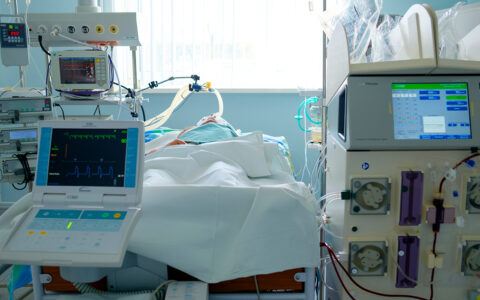Complication rates are high for critically ill patients receiving intubation, with cardiac arrest occurring in 2 to 4 percent of cases. In a study recently published in the New England Journal of Medicine, Jonathan Casey, M.D., and colleagues at Vanderbilt University Medical Center investigated the use of bag-mask ventilation on outcomes for ICU patients undergoing tracheal intubation.
“Surprisingly, no previous trial had ever evaluated the safety or efficacy of bag-mask ventilation during emergency airway management,” said Casey, who is a fourth-year critical care fellow at Vanderbilt.
The PreVent trial enrolled 401 patients in seven U.S. ICUs, randomizing patients to either receive bag-mask ventilation or no ventilation between induction and laryngoscopy. Casey says the group’s findings were strong enough evidence to drive a protocol change at Vanderbilt and encourage other centers to follow suit.
“Providing ventilation with a bag-mask device is safe and very effective, cutting the rate of severely low oxygen levels in half.”
“We found that providing ventilation with a bag-mask device is safe and very effective, cutting the rate of severely low oxygen levels in half,” Casey said.
Practice Variability
Many critically ill patients who undergo intubation experience hypoxemia, raising risks of cardiac arrest or injury to the brain and heart. Bag-mask ventilation, when applied, takes place during the minute-long interval between administration of the neuromuscular blockade and intubation. While this may prevent low oxygen levels, some fear it will fill the stomach with air and increase risk of aspiration.
Data on the relative risks and benefits, however, has been lacking. “A lot of current practice has been based on assumptions,” Casey said.
Practice differences fall, in part, along specialty lines. Emergency medicine providers frequently encounter patients with full stomachs, and many recommend against bag-mask ventilation. While more ICU pulmonologists tend to use bag-mask ventilation, Casey said, less than half of anesthesiologists routinely provide it.
The PreVent Trial
Results from the PreVent trial demonstrated that bag-mask ventilation dramatically reduced incidence of low oxygen levels. The median lowest oxygen saturation was 96 percent in the bag-mask ventilation group as compared to 93 percent in the no-ventilation group. Only 21 patients in the bag-mask ventilation group had severely low oxygen levels (< 80 percent arterial oxygen saturation), as compared with 45 patients in the no-ventilation group.
“Bag-mask ventilation didn’t affect the rate of aspiration,” Casey said. In fact, aspiration of stomach contents was less common in the bag-mask ventilation group, occurring in 2.5 percent of patients, compared to 4 percent of those in the no-ventilation group. “Proper technique, including attention to airway patency and gentle ventilation, is key to ensuring safety,” Casey says.
While the trial found no increased risk of aspiration, Casey noted that patients at very high risk of aspiration (such as those who were actively vomiting) were excluded from the PreVent study, and the effect of bag-mask ventilation could be different in those patients.
Implications for the ICU
Since the PreVent trial, critical care providers at Vanderbilt and other participating medical centers have incorporated bag-mask ventilation as a routine part of their intubation procedures. Future research will focus on the emergency department or pre-hospital setting.
Casey will be joining the faculty at Vanderbilt in July and is planning additional research, including the use of a fluid bolus to prevent peri-procedural cardiovascular collapse, and the use of a flexible rubber stylet (a bougie) to improve the success of intubation on the first attempt. He is also nearing completion of a study of post-extubation respiratory support research (the PROPER trial), which explores the best methods for avoiding reintubation.
“As a group, we’re working to develop methodologies to answer highly debated questions about routine interventions,” he said. “We’re looking at our own practices, finding areas where there is a lot of variability and trying to figure which of the commonly used approaches is actually best for patients.”




